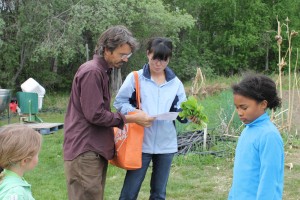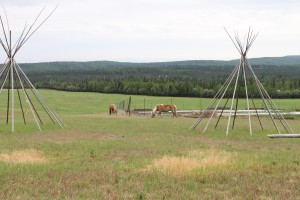Community-supported agriculture gains popularity
November 9, 2011
907-474-5042
11/9/11
After 11 years of gardening in the same raised bed, tree roots started emerging from underneath, making the garden produce less with a lot more effort required. This spring my husband said, “Let’s move the garden to a new spot.” I said, “Let’s not.”
Since I am surrounded by talk of agriculture at my university job, I had become familiar with the community supported agriculture concept and decided the time was right to let my garden rest and join Community-supported agriculture.

For the uninitiated, a CSA is simply a model where the customer pays for the season in advance and receives a share each week. While most CSAs offer produce, there are others that sell shares of milk, cheese, honey, eggs, meat, etc.
I kept my greenhouse in production (got to have those cucumbers, herbs and tomatoes!) and called Susan Kerndt of Wild Rose Farm. I knew Susan from interviewing her for this column and was wildly impressed with her dedication to sustainable farming and with the fact that she and husband Eric Mayo entice teenagers to help with the farm chores. (How do they do that?) Plus, the farm is only minutes away from the university.
Yes, they had room for me, she said. I filled out a simple form and mailed a check for $350 for 16 weeks, a half share.
I marked my calendar for every Thursday evening to make the short trek to the farm. I was so excited about my first visit but it couldn’t have come at a busier time. On June 2 I had an evening photography class, a photo assignment for my job in the woods near campus and a farewell dinner for a friend who was moving out of state the next day. Somehow I sandwiched in the CSA pickup. As I approachd the farm I began wondering, “What am I doing?” I didn’t even know if I had to take my own sacks so I asked another person parked near me. The answer of course was yes.
I walked toward the farm and instantly forgot the stress of the day. The view of the fields and horses was spectacular. I whipped out my new camera and started shooting the scenery for class. The fresh air was invigorating.

I found my way to the sign-in sheet and Mayo pointed me to the half-share table and told me to take one of each bunch. Assuming the first visit so early in the season would only yield lettuce I was amazed at the array of that initial share: Bok Choy, salad mix, Yukina Savoy, tender green onions, Asian greens and lambs’ quarters. “Wow,” I told Mayo. “I wasn’t expecting this much.” He asked if I’d be able to eat it all and I assured him it wouldn’t go to waste.
The problem was I had never eaten or cooked Bok Choy! Each pickup day the CSA provided a newsletter chock full of recipes so that was helpful. “Saute” proved the magic word for me. I ate so much sautéed Bok Choy this past summer but I never tired of its vibrant green color and unique taste. I simply washed it, chopped it up, mixed it with other veggies and moved it around in a pan with a little olive oil and herbs. Served over rice or couscous, it proved a filling and delicious dinner. It became my summer staple.
Truthfully, it never got easier to fit in the Thursday evening trip to the farm and I missed a few times when I was out of town, however, I asked a friend to take my place so someone could enjoy the bounty. Inevitably, once I pulled into the parking field near the farm, I slowed down, breathed in deeply and looked forward to seeing what would be laid out for me to take home.
Mayo and Kerndt were always weeding, watering, harvesting when I showed up so I’d check in with them about how their week had gone, and what was new in the garden or in their children’s lives. Usually at least one or two of the couple’s four children would be there too. The youngest, Else, often set up a lemonade stand at the farm, posting a sign near the parking area to alert visitors. Many times I turned back to my car for a quarter so I could purchase a beverage.
Each week the variety was incredible and the amounts grew and grew until by the end I was bringing several sacks, once even a garbage bag for my haul. As spring turned to summer the greens, from beet greens to chard to kale continued to appear but were supplemented with radishes, cabbage, turnips, onions. I had never tasted such juicy, flavorful onions.

Each interlude at Wild Rose offered respite from daily life and a feeling of belonging to something meaningful. Here was a hardworking family making a living off the land and I had a tiny part in it and I was eating healthier than ever to boot.
A bonus at Wild Rose was the spectacular beauty of the flowers. Everywhere you look there are stunning assortments of colorful flowers. There is even a CSA share for flowers but I didn’t subscribe to that. Eme Mayo creates impressive bouquets for the flower customers. Kerndt told me I could pick a few for myself so I was able to maintain a vase of lovely blossoms on my table all summer.
Occasionally there were educational workshops at the farm and even tasting sessions. I was going to bypass the fermentation table but decided to be brave and try the samples; I discovered they were not just edible but very tasty.
Soon enough I was getting broccoli, zucchini, kohlrabi, cauliflower, beets, potatoes and the crunchiest, sweetest carrots I’ve ever had. There were times when my husband was out of town that I had to share the wealth with friends, but that felt good too, to pass the fresh food along and offer suggestions on how to cook it. Other times I froze the extras for later consumption. Won’t that zucchini taste great in a winter stew or chocolate cake?
Then it all ended. Sept. 15 was the final pickup day. I experienced a twinge of sadness that the summer had passed so quickly. It was unbelievable how quickly those Thursdays rolled around.
On the last day Mayo and Kerndt went all out with food samples, fresh veggies and dips and homemade rolls baked in their outdoor oven. As I hiked back to the car, bags in tow, the smell of the hot bread hanging in the cool damp air I gave a final glance back at Wild Rose and said a silent farewell.
Interior CSA list:
Arctic Roots Farm
Basically Basil
Calypso Farm and Ecology Center
Cripple Creek Organics
Dart A&M Farm
DogWood Gardens
Feedback Farm
Rosie Creek Farm
Spinach Creek Farm
20 Mile Farm
Wild Rose Farm
This column is provided as a service by the UAF School of Natural Resources and Agricultural Sciences and the Agricultural and Forestry Experiment Station. Nancy Tarnai is the school and station’s public information officer.


